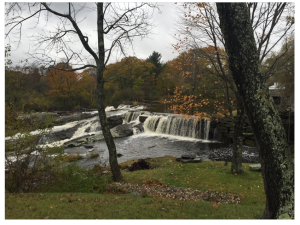Posted on January 19, 2022 by Earl Phillips

Credit: Maine Preservation
As we approach the tenth anniversary of the unanimous U.S. Supreme Court decision in PPL Montana, LLC v. Montana, 565 US 576 (2012), I find myself simultaneously wrestling with “who owns the stream bed” and the underlying property in several matters, while reviewing the PPL decision for one of the classes I teach. This decision offers a detailed historical journey via the logbooks of Louis and Clark as they traverse the spectacular western rivers, and it explores the “equal footing doctrine”, a core principle woven into the fabric of this country to encourage (or not dissuade) candidate states from joining the United States. It also helps us understand (i) that an entire river or stream need not be navigable for segments to be navigable in fact; (ii) how to determine whether a waterbody (or meaningful segment of a river) was “navigable in fact” at the time of statehood, and (iii) whether the State or the U.S. owns the stream-bed.
The decision also has direct application to a number of real world and regular situations such as: (i) acquisition, leasing, permitting, and/or operation of a hydropower facility and its related infrastructure; (ii) conveyance of an old mill with its historic dam/weir/sluiceway, and (iii) investment in or improvements to a property where there is evidence of a relic dam and/or related infrastructure bordering and extending out into the adjoining waterbody. Here are some questions that an environmental lawyer might ponder in such a situation:
- Does the hydropower facility have a license from FERC and if so, is the facility in full compliance?
- Does the dam/weir/sluiceway have a dam or dam safety permit or certificate from any/all State agencies and if so, is it in compliance with such dam permits?
- Has the facility secured all required federal, state, and/or local inland wetlands and watercourse permits and if so, is it in compliance with all such permits?
- Will the facility require repairs or improvements?
- Does the sediment impounded behind the dam need to be dredged or removed?
- Is that sediment contaminated, and if so, how will it be managed?
While all of these issues may be important, at the very core is a seemingly simple question: who owns the stream-bed, and what does that mean for achieving compliance, development, risk management, and/or transactional objectives? Real property laws may vary as to who holds that ownership interest. Review of the tax or assessor’s maps may suggest that: (i) the landowner who owns property on both sides of a waterbody may have property rights over under that waterbody as well, or (ii) the owners of property on either side of a waterbody own to the centerline under that waterbody on their respective sides. A title search may then confirm who deeded what to whom with respect to the land underlying the waterbody.
But it is not wise to stop the analysis there. While traditional real estate law may suggest that one or more parties may own the property underlying the waterbody, that may not be true with respect to the stream-bed itself. Ideally, this will be revealed in the land records, a title insurance policy, or a specific state statute, but that is not always the case. In PPL Montana, LLC v. Montana, the Court confirmed that: (i) relative to who owns the stream-bed (the federal government or state government), the state is the owner if, at the time of statehood, the waterbody was navigable by then-in-use watercraft. If it was not, the federal government is the owner of the stream-bed. The Court also held that (ii) when considering whether a particular body of water is “navigable in fact”, it may be sufficient to consider meaningful segments of the waterbody in question when determining whether the waterbody qualifies as having been navigable or non-navigable at the time of statehood.
Finally, we need to recognize that common definitions of stream-bed are imprecise, such as the online Merriam-Webster definition of “the channel occupied or formerly occupied by a stream” and the online LawInsider definition of “the substrate of a stream, as measured between the ordinary high water mark along each sides of a stream.” In this context, consider as well the consequences of climate change, with greater precipitation in certain parts of the country and less in others, along with changes in river/stream flow dynamics resulting from urbanization and impermeable surfaces that could produce “stream-beds” considerably different from those identified just a few years ago.
WHAT does this mean in the transactional, compliance, or development context as related to properties bordering waterbodies or in which waterbodies exist? Heightened awareness, and increased analysis and planning may be in order.
